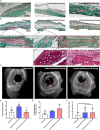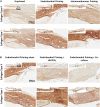A Developmental Engineering-Based Approach to Bone Repair: Endochondral Priming Enhances Vascularization and New Bone Formation in a Critical Size Defect
- PMID: 32296687
- PMCID: PMC7137087
- DOI: 10.3389/fbioe.2020.00230
A Developmental Engineering-Based Approach to Bone Repair: Endochondral Priming Enhances Vascularization and New Bone Formation in a Critical Size Defect
Abstract
There is a distinct clinical need for new therapies that provide an effective treatment for large bone defect repair. Herein we describe a developmental approach, whereby constructs are primed to mimic certain aspects of bone formation that occur during embryogenesis. Specifically, we directly compared the bone healing potential of unprimed, intramembranous, and endochondral primed MSC-laden polycaprolactone (PCL) scaffolds. To generate intramembranous constructs, MSC-seeded PCL scaffolds were exposed to osteogenic growth factors, while endochondral constructs were exposed to chondrogenic growth factors to generate a cartilage template. Eight weeks after implantation into a cranial critical sized defect in mice, there were significantly more vessels present throughout defects treated with endochondral constructs compared to intramembranous constructs. Furthermore, 33 and 50% of the animals treated with the intramembranous and endochondral constructs respectively, had full bone union along the sagittal suture line, with significantly higher levels of bone healing than the unprimed group. Having demonstrated the potential of endochondral priming but recognizing that only 50% of animals completely healed after 8 weeks, we next sought to examine if we could further accelerate the bone healing capacity of the constructs by pre-vascularizing them in vitro prior to implantation. The addition of endothelial cells alone significantly reduced the healing capacity of the constructs. The addition of a co-culture of endothelial cells and MSCs had no benefit to either the vascularization or mineralization potential of the scaffolds. Together, these results demonstrate that endochondral priming alone is enough to induce vascularization and subsequent mineralization in a critical-size defect.
Keywords: bone tissue engineering; endochondral ossification; intramembranous ossification; mesenchymal stem cells; pre-vascularization.
Copyright © 2020 Freeman, Brennan, Browe, Renaud, De Lima, Kelly, McNamara and Layrolle.
Figures




Similar articles
-
An Endochondral Ossification-Based Approach to Bone Repair: Chondrogenically Primed Mesenchymal Stem Cell-Laden Scaffolds Support Greater Repair of Critical-Sized Cranial Defects Than Osteogenically Stimulated Constructs In Vivo.Tissue Eng Part A. 2016 Mar;22(5-6):556-67. doi: 10.1089/ten.TEA.2015.0457. Tissue Eng Part A. 2016. PMID: 26896424
-
An in vitro bone tissue regeneration strategy combining chondrogenic and vascular priming enhances the mineralization potential of mesenchymal stem cells in vitro while also allowing for vessel formation.Tissue Eng Part A. 2015 Apr;21(7-8):1320-32. doi: 10.1089/ten.TEA.2014.0249. Epub 2015 Mar 3. Tissue Eng Part A. 2015. PMID: 25588588
-
3D bioprinting of cartilaginous templates for large bone defect healing.Acta Biomater. 2023 Jan 15;156:61-74. doi: 10.1016/j.actbio.2022.07.037. Epub 2022 Jul 28. Acta Biomater. 2023. PMID: 35907556
-
Recapitulating endochondral ossification: a promising route to in vivo bone regeneration.J Tissue Eng Regen Med. 2015 Aug;9(8):889-902. doi: 10.1002/term.1918. Epub 2014 Jun 11. J Tissue Eng Regen Med. 2015. PMID: 24916192 Review.
-
Endochondral Priming: A Developmental Engineering Strategy for Bone Tissue Regeneration.Tissue Eng Part B Rev. 2017 Apr;23(2):128-141. doi: 10.1089/ten.TEB.2016.0197. Epub 2016 Nov 22. Tissue Eng Part B Rev. 2017. PMID: 27758156 Review.
Cited by
-
Recent Advances on Cell-Based Co-Culture Strategies for Prevascularization in Tissue Engineering.Front Bioeng Biotechnol. 2021 Nov 25;9:745314. doi: 10.3389/fbioe.2021.745314. eCollection 2021. Front Bioeng Biotechnol. 2021. PMID: 34900955 Free PMC article. Review.
-
Towards Polycaprolactone-Based Scaffolds for Alveolar Bone Tissue Engineering: A Biomimetic Approach in a 3D Printing Technique.Int J Mol Sci. 2023 Nov 10;24(22):16180. doi: 10.3390/ijms242216180. Int J Mol Sci. 2023. PMID: 38003368 Free PMC article. Review.
-
Chondrogenic and BMP-4 primings confer osteogenesis potential to human cord blood mesenchymal stromal cells delivered with biphasic calcium phosphate ceramics.Sci Rep. 2021 Mar 24;11(1):6751. doi: 10.1038/s41598-021-86147-9. Sci Rep. 2021. PMID: 33762629 Free PMC article.
-
In Vitro Mineralisation of Tissue-Engineered Cartilage Reduces Endothelial Cell Migration, Proliferation and Tube Formation.Cells. 2023 Apr 20;12(8):1202. doi: 10.3390/cells12081202. Cells. 2023. PMID: 37190110 Free PMC article.
-
Bone defect reconstruction via endochondral ossification: A developmental engineering strategy.J Tissue Eng. 2021 Mar 30;12:20417314211004211. doi: 10.1177/20417314211004211. eCollection 2021 Jan-Dec. J Tissue Eng. 2021. PMID: 33868628 Free PMC article. Review.
References
-
- Brennan M. A., Renaud A., Gamblin A. L., D’Arros C., Nedellec S., Trichet V., et al. (2015). 3D cell culture and osteogenic differentiation of human bone marrow stromal cells plated onto jet-sprayed or electrospun micro-fiber scaffolds. Biomed. Mater. 10:045019. 10.1088/1748-6041/10/4/045019 - DOI - PubMed
LinkOut - more resources
Full Text Sources

